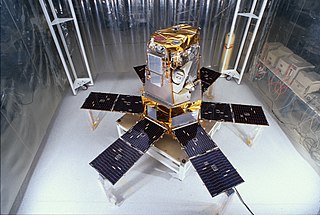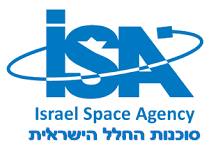Related Research Articles

The Cassini–Huygens space-research mission, commonly called Cassini, involved a collaboration among NASA, the European Space Agency (ESA), and the Italian Space Agency (ASI) to send a space probe to study the planet Saturn and its system, including its rings and natural satellites. The Flagship-class robotic spacecraft comprised both NASA's Cassini space probe and ESA's Huygens lander, which landed on Saturn's largest moon, Titan. Cassini was the fourth space probe to visit Saturn and the first to enter its orbit. The two craft took their names from the astronomers Giovanni Cassini and Christiaan Huygens.

Vega, is an expendable launch system in use by Arianespace jointly developed by the Italian Space Agency (ASI) and the European Space Agency (ESA). Development began in 1998 and the first launch took place from the Centre Spatial Guyanais on 13 February 2012.

The Italian Space Agency is a government agency established in 1988 to fund, regulate and coordinate space exploration activities in Italy. The agency cooperates with numerous national and international entities who are active in aerospace research and technology.

Multispectral imaging captures image data within specific wavelength ranges across the electromagnetic spectrum. The wavelengths may be separated by filters or detected via the use of instruments that are sensitive to particular wavelengths, including light from frequencies beyond the visible light range, i.e. infrared and ultra-violet. Spectral imaging can allow extraction of additional information the human eye fails to capture with its visible receptors for red, green and blue. It was originally developed for military target identification and reconnaissance. Early space-based imaging platforms incorporated multispectral imaging technology to map details of the Earth related to coastal boundaries, vegetation, and landforms. Multispectral imaging has also found use in document and painting analysis.4

The Solar Radiation and Climate Experiment (SORCE) was a NASA-sponsored satellite mission that measured incoming X-ray, ultraviolet, visible, near-infrared, and total solar radiation. These measurements specifically addressed long-term climate change, natural variability, atmospheric ozone, and UV-B radiation, enhancing climate prediction. These measurements are critical to studies of the Sun, its effect on our Earth system, and its influence on humankind. SORCE was launched on 25 January 2003 on a Pegasus XL launch vehicle to provide NASA's Earth Science Enterprise (ESE) with precise measurements of solar radiation.

Hyperspectral imaging, like other spectral imaging, collects and processes information from across the electromagnetic spectrum. The goal of hyperspectral imaging is to obtain the spectrum for each pixel in the image of a scene, with the purpose of finding objects, identifying materials, or detecting processes. There are three general branches of spectral imagers. There are push broom scanners and the related whisk broom scanners, which read images over time, band sequential scanners, which acquire images of an area at different wavelengths, and snapshot hyperspectral imaging, which uses a staring array to generate an image in an instant.

The Israel Space Agency is a governmental body, a part of Israel's Ministry of Science and Technology, that coordinates all Israeli space research programs with scientific and commercial goals.

Metop is a series of three polar-orbiting meteorological satellites developed by the European Space Agency (ESA) and operated by the European Organisation for the Exploitation of Meteorological Satellites (EUMETSAT). The satellites form the space segment component of the overall EUMETSAT Polar System (EPS), which in turn is the European half of the EUMETSAT / NOAA Initial Joint Polar System (IJPS). The satellites carry a payload comprising 11 scientific instruments and two which support Cospas-Sarsat Search and Rescue services. In order to provide data continuity between Metop and NOAA Polar Operational Environmental Satellites (POES), several instruments are carried on both fleets of satellites.

Venera-D is a proposed Russian space mission to Venus that would include an orbiter and a lander to be launched in 2029. The orbiter's prime objective is to perform observations with the use of a radar. The lander, based on the Venera design, would be capable of operating for a long duration on the planet's surface. The "D" in Venera-D stands for "dolgozhivushaya," which means "long lasting" in Russian.

The visible and near-infrared (VNIR) portion of the electromagnetic spectrum has wavelengths between approximately 400 and 1100 nanometers (nm). It combines the full visible spectrum with an adjacent portion of the infrared spectrum up to the water absorption band between 1400 and 1500 nm. Some definitions also include the short-wavelength infrared band from 1400 nm up to the water absorption band at 2500 nm. VNIR multi-spectral image cameras have wide applications in remote sensing and imaging spectroscopy. Hyperspectral Imaging Satellite carried two payloads, among which one was working on the spectral range of VNIR.

The Jupiter Icy Moons Explorer (JUICE) is an interplanetary spacecraft in development by the European Space Agency (ESA) with Airbus Defence and Space as the main contractor. The mission will study three of Jupiter's Galilean moons: Ganymede, Callisto, and Europa all of which are thought to have significant bodies of liquid water beneath their surfaces, making them potentially habitable environments.

Rosalind Franklin, previously known as the ExoMars rover, is a planned robotic Mars rover, part of the international ExoMars programme led by the European Space Agency and the Russian Roscosmos State Corporation. The mission was scheduled to launch in July 2020, but was postponed to 2022.
PRISMA is an Italian Space Agency pre-operational and technology demonstrator mission focused on the development and delivery of hyperspectral products and the qualification of the hyperspectral payload in space.

Sentinel-5 Precursor (Sentinel-5P) is an Earth observation satellite developed by ESA as part of the Copernicus Programme to close the gap in continuity of observations between Envisat and Sentinel-5.
Sentinel-4 is a European Earth observation mission developed to support the European Union Copernicus Programme for monitoring the Earth. It focuses on monitoring of trace gas concentrations and aerosols in the atmosphere to support operational services covering air-quality near-real time applications, air-quality protocol monitoring and climate protocol monitoring. The specific objective of Sentinel-4 is to support this with a high revisit time over Europe.
The Atmospheric Chemistry Suite (ACS) is a science payload consisting of three infrared spectrometer channels abord the ExoMars Trace Gas Orbiter (TGO) orbiting Mars since October 2016. The three channels are: the near-infrared channel (NIR), the mid-infrared channel (MIR), and the far infrared channel.

MicrOmega-IR is an infrared hyperspectral microscope that is part of the science payload on board the European Rosalind Franklin rover, tasked to search for biosignatures on Mars. The rover is planned to land on Mars in spring 2023. MicrOmega-IR will analyse in situ the powder material derived from crushed samples collected by the rover's core drill.

See also: Hico (disambiguation).

OPTSAT-3000, or SHALOM is an Italian Earth observation and reconnaissance satellite developed and built by Israel Aerospace Industries and operated by the Italian Ministry of Defence. Launched on August 2, 2017, it has an expected service life of at least 7 years. It is based on the design of the TecSAR-1 satellite.
References
- 1 2 3 4 "Agenzia Spaziale Italiana Annual Report 2020" (PDF). ASI . 30 August 2021. p. 31. Retrieved 6 December 2021.
- 1 2 3 4 Demetio Labate (March 2017). "SHALOM Mission" (PDF). Workshop :“Data Exploitation della missione PRISMA, precursore delle missioni iperspettrali nazionali”.
- 1 2 3 "Piano Triennale delle Attività 2021-2023" [Three-year Plan of Activities 2021-2023](PDF). ASI (in Italian). 10 March 2021. p. 50. Retrieved 6 December 2021.
- 1 2 3 "Dal 2022 in orbita il satellite dalla super-vista" [Hyperspectral satellite to orbit in 2022]. ANSA (in Italian). 3 July 2019. Retrieved 4 November 2019.
- ↑ "Zvi Kaplan, Director, Israel Space Agency". Spacenews. Retrieved 21 November 2013.
- ↑ "Italy and Israel: all clear for SHALOM". Italian Space Agency . Retrieved 21 November 2013.
- ↑ Dekel, Tal. "Israeli Civilian Space Program: Turning Swords into Plowshares" (PDF). Israel Space Agency . Retrieved 21 November 2013.
- ↑ "SELEX Galileo in Charge of Hyperspectral Instrument for Italian-Israeli SHALOM Space Mission". Selex ES . Retrieved 21 November 2013.
- 1 2 Eyal Ben Dor, Avia Kafri, Giancarlo Varacalli (July 2014). "SHALOM: Spaceborne Hyperspectral Applicative Land and Ocean Mission: A joint project of ASI-ISA, an update for 2014" (PDF). IGARSS Quebec.CS1 maint: multiple names: authors list (link)
- ↑ "The Shalom Mission". Israel Space Agency. December 16, 2014.
- ↑ "Israel, Italy To Build Hyperspectral Satellites". Archived from the original on 3 December 2013. Retrieved 21 November 2013.
- ↑ Prof. Ezio Bussoletti. "Space Observations for Agriculture and Food Support" (PDF). Italian Space Agency . Retrieved 21 November 2013.